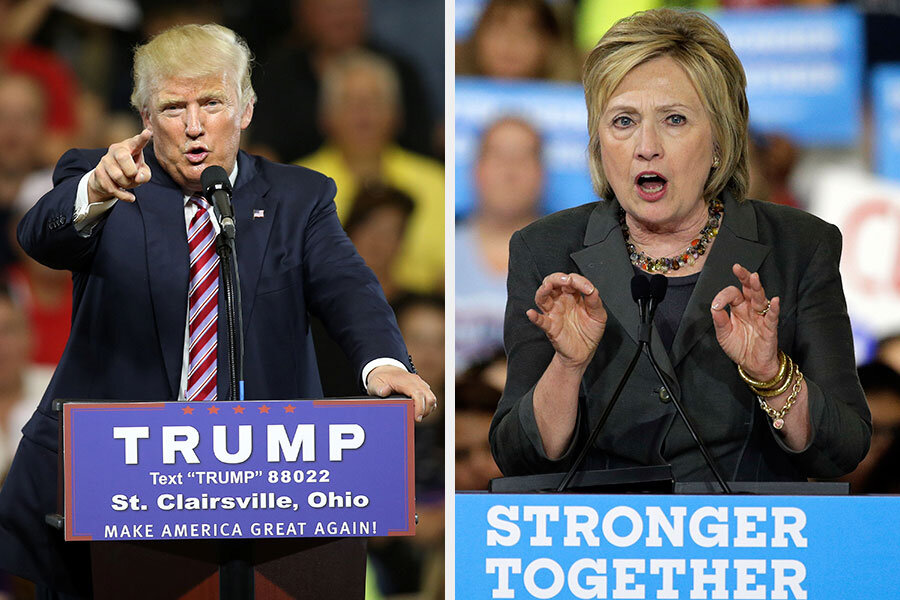How 2016 became the fact-check election
Loading...
| Washington
Professional fact-checkers might be excused for being a tad exhausted this campaign season.
Tracking the public statements of 22 major-party candidates during the primaries was one thing. But a general election pitting Donald Trump against Hillary Clinton – two candidates with abysmal scores for honesty among voters – is another, sending the fact-checking world into overdrive.
Is Mr. Trump really worth $10 billion, as he claims? (Not according to Forbes magazine.) Is it true that Mrs. Clinton “slept” during the Benghazi terror attack in 2012, as Trump says? (No, according to Clinton testimony.) Was Clinton allowed to use a personal email server when she was secretary of State, as she has asserted? (No, according to a recent report by the State Department’s Office of the inspector general.)
Trump alone is enough to keep the entire fact-checking industry afloat. When the flamboyant billionaire gave a big speech recently denouncing Clinton, the Associated Press assigned 12 reporters just to check the veracity of his assertions – “a whole platoon of journalistic talent that could have been doing other things,” moaned Washington Post media critic Erik Wemple.
It’s easy to get discouraged by all the charges of lying hurled around – Lyin’ Ted, LyingCrookedHillary (both a verbal Trump charge and the name of a Trump campaign site), handouts from the Clinton campaign that lay out Trump’s “lies, hypocrisy, and catastrophic ideas.” And certainly, to some voters, the whole tone of the campaign is so depressing, the answer is just to tune out and stay home on Election Day.
But to veteran fact-checkers, it’s the time to shine. Angie Drobnic Holan, editor in chief of the Pulitzer Prize-winning site PolitiFact.com, says she’s “really optimistic,” citing the growth of media fact-checking.
“You can have a cynical take on that, but mine is more optimistic,” because fact-checking is especially needed this year, she says. “Donald Trump is a candidate who has persistent problems with accuracy, and I’m heartened that there’s widespread recognition that this is someone who needs to be fact-checked.”
Trump supporters, not surprisingly, disagree. Jeffrey Lord, a regular on CNN defending Trump, calls media fact-checkers “elitist” and says the candidates themselves do a better job of countering each other’s assumptions.
This “self-policing” concept sounds a bit like having a basketball game with no referees. And besides, it’s just not going to happen. Media fact-checking is here to stay. So are politicians who say things that aren’t true and accuse each other of lying. But there’s a spectrum of political speech: There are out-and-out lies – deliberately false statements meant to deceive – then there are statements that are unintentionally false, exaggerations, and spin. Sorting through the differences can be impossible, as it requires knowing what’s inside the speaker’s head.
And what about a candidate who makes big promises, knowing they can’t be fulfilled? That’s another form of political speech that is less-than-truthful, but which voters have come to expect – and often excuse.
In a recent focus group, veteran pollster Peter Hart asked 12 Republicans if they thought a President Trump would ever actually build a wall across the Mexican border. Eight people voted no. Same with his promise to deport the 11 million illegal immigrants in the US. And yet most of the 12 were fine that these promises would likely go unfulfilled.
“They don’t hear a pledge, they hear, ‘I’m going to do something,’ “ says Kathleen Hall Jamieson, director of the University of Pennsylvania’s Annenberg Public Policy Center, which sponsored the focus group.
But making pie-in-the-sky promises is one thing. Statements of fact that prove false are another, and that’s where fact-checkers are having a field day. PolitiFact has judged 174 statements by Trump so far, and found only 16 to be either true or mostly true. Seventy have been judged false, and another 34 rated “Pants on Fire,” referring to claims that are “not only inaccurate but also ridiculous,” according to Ms. Holan.
With Clinton, PolitiFact has judged 218 statements and rated 112 true or mostly true, 24 false, and three “Pants on Fire.”
The next question is whether the assessments of PolitiFact and other fact-checkers actually penetrate public consciousness?
“Our traffic is better than it’s ever been,” says Holan, whose site is affiliated with the Tampa Bay Times. “Media organizations are doing fact-checking in part because it’s very popular with readers.”
Professor Jamieson, whose Annenberg center launched the first political fact-checking website, FactCheck.org, in 2003, is less sanguine.
“Fact-checking has never been more important, more complicated, and less likely to reach its target audience with the desired corrected information,” Jamieson says.
Part of the problem is the ever-accelerating news cycle. “In order to get a correction through, you have to get people to stand still long enough to hear it,” she says.
Another issue, particularly for fact-checking operations attached to news sites, is low public opinion of the media. Only 6 percent of Americans have a “great deal of confidence” in the press, according to a survey released in April by the Media Insight Project.
Holan of PolitiFact says that when readers accuse her site of partisan bias against Trump, she counters with data that show Republicans who do well on the PolitiFact “Truth-o-Meter,” such as Jeb Bush.
Of course, former Governor Bush didn’t do very well as a presidential candidate; voters don’t necessarily favor a candidate because he or she is more factual. Moreover, for a slice of the electorate, this cycle reflects a break from politics as usual – and that includes an embrace of candidates who speak to voters without the filter of polls, focus groups, and scripted statements.







